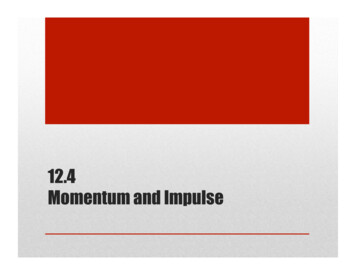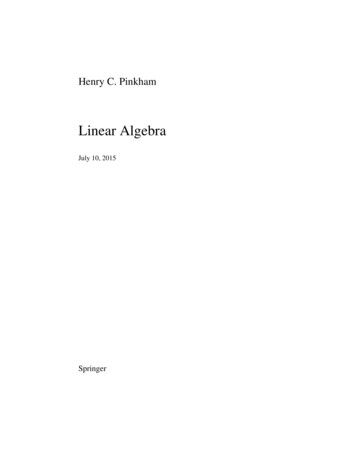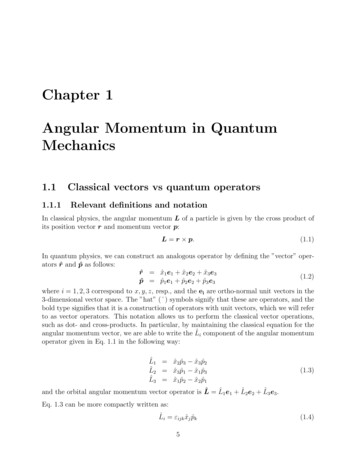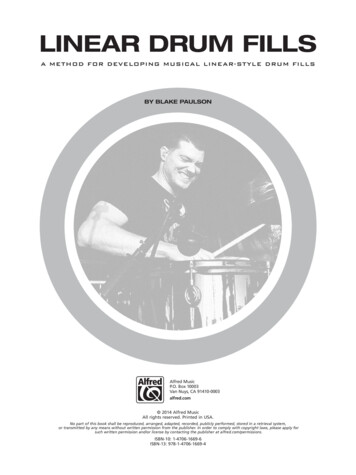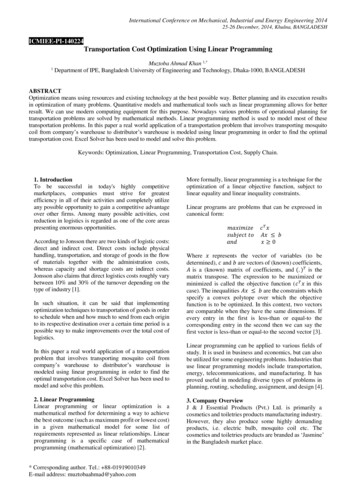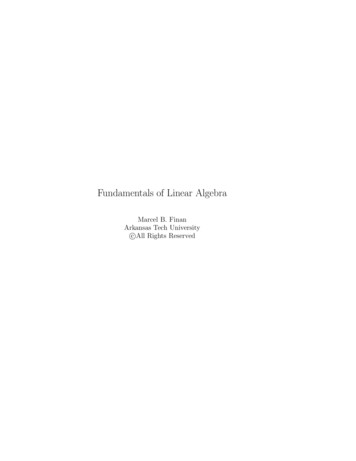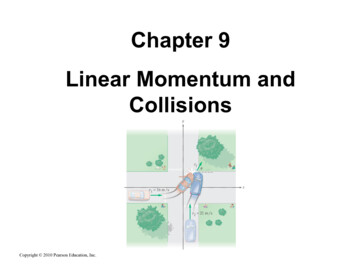
Transcription
Chapter 9Linear Momentum andCollisionsCopyright 2010 Pearson Education, Inc.
Units of Chapter 9 Linear Momentum Momentum and Newton’s Second Law Impulse Conservation of Linear Momentum Inelastic Collisions Elastic CollisionsCopyright 2010 Pearson Education, Inc.
9-1 Linear MomentumMomentum is a vector; its direction is thesame as the direction of the velocity.Copyright 2010 Pearson Education, Inc.
9-1 Linear MomentumChange in momentum:(a) mv(b) 2mvCopyright 2010 Pearson Education, Inc.
Momentum in collisionsConsider two interacting bodies with m2 m1:m1F21F12m2FnetIf we know the net force on each body then !v a!t !tmThe velocity change for each mass will be different if themasses are different.Copyright 2010 Pearson Education, Inc.
Rewrite the previous result for each body as:m1!v1 F21!tm2 !v 2 F12 !t "F21!tCombine the two results:m1"v1 !m2 "v 2m1 (v1 f ! v1i ) !m2 (v 2 f ! v 2i )Copyright 2010 Pearson Education, Inc.
m1!v1 "m2 !v 2!p1 "!p 2The change in momentum of the two bodies is “equal andopposite”. Total momentum is conserved during theinteraction; the momentum lost by one body is gained bythe other.Copyright 2010 Pearson Education, Inc.
9-2 Momentum and Newton’s Second LawNewton’s second law, as we wrote it before:is only valid for objects that have constantmass. Here is a more general form, alsouseful when the mass is changing:Copyright 2010 Pearson Education, Inc.
9-3 ImpulseImpulse is a vector, in the same directionas the average force.Copyright 2010 Pearson Education, Inc.
9-3 ImpulseWe can rewriteasSo we see thatThe impulse is equal to the change inmomentum.Copyright 2010 Pearson Education, Inc.
9-3 ImpulseTherefore, the samechange in momentummay be produced by alarge force acting for ashort time, or by asmaller force acting for alonger time.Copyright 2010 Pearson Education, Inc.
9-4 Conservation of Linear MomentumThe net force acting on an object is the rateof change of its momentum:If the net force is zero, the momentum does notchange:Copyright 2010 Pearson Education, Inc.
Example: A force of 30 N is applied for 5 sec to each of twobodies of different masses.30 NTake m1 m2m1 or m2(a) Which mass has the greater momentum change?!p F!tCopyright 2010 Pearson Education, Inc.Since the same force is applied toeach mass for the same interval, Δpis the same for both masses.
Example continued:(b) Which mass has the greatest velocity change?!p!v mSince both masses have the same Δp,the smaller mass (mass 1) will have thelarger change in velocity.(c) Which mass has the greatest acceleration?!va !tCopyright 2010 Pearson Education, Inc.Since a Δv the mass with the greatervelocity change will have the greatestacceleration (mass 1).
Example: An object of mass 3.0 kg is allowed to fall fromrest under the force of gravity for 3.4 seconds. What is thechange in momentum? Ignore air resistance.Want Δp mΔv.!v a!t!v " g!t "33.3 m/sec!p m!v 100 kg m/s (downward)Copyright 2010 Pearson Education, Inc.
Example: What average force is necessary to bring a 50.0kg sled from rest to 3.0 m/s in a period of 20.0 seconds?Assume frictionless ice.!p Fav !t!p m!vFav !t!t(50.0 kg )(3.0 m/s )Fav 7.5 N20.0 sCopyright 2010 Pearson Education, Inc.The force will bein the directionof motion.
9-4 Conservation of Linear MomentumInternal Versus External Forces:Internal forces act between objects within thesystem.As with all forces, they occur in action-reactionpairs. As all pairs act between objects in thesystem, the internal forces always sum to zero:Therefore, the net force acting on a system isthe sum of the external forces acting on it.Copyright 2010 Pearson Education, Inc.
9-4 Conservation of Linear MomentumFurthermore, internal forces cannot change themomentum of a system.However, the momenta of components of thesystem may change.Copyright 2010 Pearson Education, Inc.
9-4 Conservation of Linear MomentumAn example of internal forces movingcomponents of a system:Copyright 2010 Pearson Education, Inc.
Example: A rifle has a mass of 4.5 kg and it fires a bullet of10.0 grams at a muzzle speed of 820 m/s. What is the recoilspeed of the rifle as the bullet leaves the barrel?As long as the rifle is horizontal, there will be no netexternal force acting on the rifle-bullet system andmomentum will be conserved.pi p f0 mb vb mr vr' 0.01 kg mb""820 m/s !1.82 m/svr !vb !%%mr& 4.5 kg #Copyright 2010 Pearson Education, Inc.
9-5 Inelastic CollisionsCollision: two objects striking one anotherTime of collision is short enough that externalforces may be ignoredInelastic collision: momentum is conserved butkinetic energy is notCompletely inelastic collision: objects sticktogether afterwardsCopyright 2010 Pearson Education, Inc.
9-5 Inelastic CollisionsA completely inelastic collision:Copyright 2010 Pearson Education, Inc.
9-5 Inelastic CollisionsSolving for the final momentum in terms of theinitial momenta and masses:Copyright 2010 Pearson Education, Inc.
9-5 Inelastic CollisionsBallistic pendulum: the height h can be foundusing conservation of mechanical energy afterthe object is embedded in the block.Copyright 2010 Pearson Education, Inc.
9-5 Inelastic CollisionsFor collisions in two dimensions, conservationof momentum is applied separately along eachaxis:Copyright 2010 Pearson Education, Inc.
9-6 Elastic CollisionsIn elastic collisions, both kinetic energy andmomentum are conserved.One-dimensional elastic collision:Copyright 2010 Pearson Education, Inc.
9-6 Elastic CollisionsWe have two equations (conservation ofmomentum and conservation of kinetic energy)and two unknowns (the final speeds). Solving forthe final speeds:Copyright 2010 Pearson Education, Inc.
9-6 Elastic CollisionsTwo-dimensional collisions can only be solved ifsome of the final information is known, such asthe final velocity of one object:Copyright 2010 Pearson Education, Inc.
Example: In a railroad freight yard, an empty freight car ofmass m rolls along a straight level track at 1.0 m/s andcollides with an initially stationary, fully loaded, boxcar ofmass 4.0m. The two cars couple together upon collision.(a) What is the speed of the two cars after the collision?pi p fp1i p2i p1 f p2 fm1v1 0 m1v m2 v (m1 m2 )v& m1 #!!v1 0.2 m/sv % m1 m2 "Copyright 2010 Pearson Education, Inc.
Example continued:(b) Suppose instead that both cars are at rest after thecollision. With what speed was the loaded boxcar movingbefore the collision if the empty one had v1i 1.0 m/s.pi p fp1i p2i p1 f p2 fm1v1i m2 v2i 0 0' m1 v2i !%% ""v1i !0.25 m/s& m2 #Copyright 2010 Pearson Education, Inc.
Example: A projectile of 1.0 kg mass approaches a stationarybody of 5.0 kg mass at 10.0 m/s and, after colliding, reboundsin the reverse direction along the same line with a speed of 5.0m/s. What is the speed of the 5.0 kg mass after the collision?pi p fp1i p2i p1 f p2 fm1v1i 0 m1v1 f m2 v2 fv2 fm1(v1i ! v1 f ) m21.0 kg(10 m/s ! (! 5.0 m/s)) 3.0 m/s 5.0 kgCopyright 2010 Pearson Education, Inc.
Example (text problem 7.58): Body A of mass M has anoriginal velocity of 6.0 m/s in the x-direction toward astationary body (B) of the same mass. After the collision,body A has vx 1.0 m/s and vy 2.0 m/s. What is themagnitude of body B’s velocity after the collision?FinalInitialAAvAiBBCopyright 2010 Pearson Education, Inc.
Example continued:y momentum:x momentum:pix p fxpiy p fyp1ix p2ix p1 fx p2 fxp1iy p2iy p1 fy p2 fym1v1ix 0 m1v1 fx m2 v2 fxSolve for v2fx:v2 fx m1v1ix ! m1v1 fxm2 v1ix ! v1 fx0 0 m1v1 fy m2 v2 fySolve for v2fy:v2 fy ! m1v1 fym2 !v1 fy !2.00 m/s 5.00 m/sThe mag. of v2 isCopyright 2010 Pearson Education, Inc.v2 f v 2 2 fy v 2 2 fx 5.40 m/s
9-7 Center of MassThe center of mass of a system is the point wherethe system can be balanced in a uniformgravitational field.Copyright 2010 Pearson Education, Inc.
9-7 Center of MassFor two objects:The center of mass is closer to the moremassive object.Copyright 2010 Pearson Education, Inc.
9-7 Center of MassThe center of mass need not be within the object:Copyright 2010 Pearson Education, Inc.
9-7 Center of MassMotion of the center of mass:Copyright 2010 Pearson Education, Inc.
Example: Particle A is at the origin and has a mass of 30.0grams. Particle B has a mass of10.0 grams. Where must particle B be located so that thecenter of mass (marked with a red x) is located at the point(2.0 cm, 5.0 cm)?yxACopyright 2010 Pearson Education, Inc.xxcmma xa mb xbmb xb ma mbma mbycmma ya mb ybmb yb ma mbma mb
Example continued:xcm (10 g )xb10 g 30gxb 8 cmCopyright 2010 Pearson Education, Inc. 2 cmycm (10 g )yb30 g 10 gyb 20 cm 5 cm
Example: The positions of three particles are (4.0 m, 0.0 m),(2.0 m, 4.0 m), and ( 1.0 m, 2.0 m). The masses are 4.0 kg,6.0 kg, and 3.0 kg respectively. What is the location of thecenter of mass?y213Copyright 2010 Pearson Education, Inc.x
Example continued:xcmm1 x1 m2 x2 m3 x3 m1 m2 m3(4 kg )(4 m ) (6 kg )(2 m ) (3 kg )(! 1 m ) (4 6 3)kg 1.92 mycmm1 y1 m2 y2 m3 y3 m1 m2 m3(4 kg )(0 m ) (6 kg )(4 m ) (3 kg )(! 2 m ) (4 6 3)kg 1.38 mCopyright 2010 Pearson Education, Inc.
9-7 Center of MassThe total mass multiplied by the acceleration ofthe center of mass is equal to the net externalforce:The center of massaccelerates just asthough it were a pointparticle of mass Macted on byCopyright 2010 Pearson Education, Inc.
Example: Body A has a mass of 3.0 kg and vx 14.0 m/s.Body B has a mass of 4.0 kg and has vy 7.0 m/s. What isthe velocity of the center of mass of the two bodies?Consider a body made up of many different masseseach with a mass mi.The position of each mass is ri and the displacement ofeach mass is Δri viΔt.Copyright 2010 Pearson Education, Inc.
Example continued:! m "r"t !miFor the center of mass:"rcm v cmiiiiSolving for the velocity of the center of mass:v cm"ri"t i m! i! mii!m v!miiiiiOr in component form:!m v !mi i,xv cm,xiiiCopyright 2010 Pearson Education, Inc.!m v !mi i, yv cm,yiii
Example continued:Applying the previous formulas to the example,vcm, x ma va , x mb vb , xma mb(3 kg )(14 m/s ) (4 kg )(0 m/s ) 6 m/s(3 4)kgvcm, y ma va , y mb vb , yma mb(3 kg )(0 m/s ) (4 kg )(! 7 m/s ) !4 m/s(3 4)kgCopyright 2010 Pearson Education, Inc.
9-8 Systems with Changing Mass:Rocket PropulsionIf a mass of fuel Δm is ejected from a rocketwith speed v, the change in momentum of therocket is:The force, or thrust, isCopyright 2010 Pearson Education, Inc.
9-4 Conservation of Linear Momentum Internal Versus External Forces: Internal forces act between objects within the system. As with all forces, they occur in action-reaction pairs. As all pairs act between objects in the system, the internal forces always su


